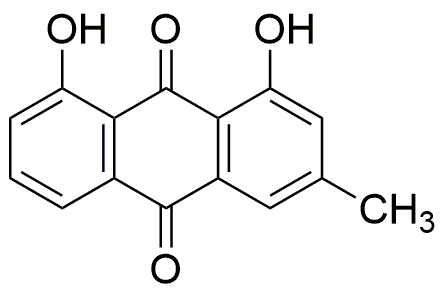Chrysophanic acid is widely utilized in research focused on:
- Pharmaceutical Development: This compound is explored for its potential anti-inflammatory and antimicrobial properties, making it a candidate for developing new medications.
- Agricultural Applications: It is used as a natural fungicide in agriculture, helping to protect crops from fungal infections while being environmentally friendly.
- Cosmetic Formulations: Due to its skin-soothing properties, chrysophanic acid is incorporated into skincare products aimed at treating conditions like eczema and psoriasis.
- Dyes and Pigments: This chemical serves as a dye in textiles and other materials, providing vibrant colors that are often more sustainable than synthetic alternatives.
- Biochemical Research: Researchers utilize chrysophanic acid to study its effects on cellular processes, contributing to a better understanding of various biological mechanisms.
General Information
Properties
Safety and Regulations
Applications
Chrysophanic acid is widely utilized in research focused on:
- Pharmaceutical Development: This compound is explored for its potential anti-inflammatory and antimicrobial properties, making it a candidate for developing new medications.
- Agricultural Applications: It is used as a natural fungicide in agriculture, helping to protect crops from fungal infections while being environmentally friendly.
- Cosmetic Formulations: Due to its skin-soothing properties, chrysophanic acid is incorporated into skincare products aimed at treating conditions like eczema and psoriasis.
- Dyes and Pigments: This chemical serves as a dye in textiles and other materials, providing vibrant colors that are often more sustainable than synthetic alternatives.
- Biochemical Research: Researchers utilize chrysophanic acid to study its effects on cellular processes, contributing to a better understanding of various biological mechanisms.
Documents
Safety Data Sheets (SDS)
The SDS provides comprehensive safety information on handling, storage, and disposal of the product.
Product Specification (PS)
The PS provides a comprehensive breakdown of the product’s properties, including chemical composition, physical state, purity, and storage requirements. It also details acceptable quality ranges and the product's intended applications.
Certificates of Analysis (COA)
Search for Certificates of Analysis (COA) by entering the products Lot Number. Lot and Batch Numbers can be found on a product’s label following the words ‘Lot’ or ‘Batch’.
Numéro de catalogue
Numéro de lot/série
Certificates Of Origin (COO)
This COO confirms the country where the product was manufactured, and also details the materials and components used in it and whether it is derived from natural, synthetic, or other specific sources. This certificate may be required for customs, trade, and regulatory compliance.
Numéro de catalogue
Numéro de lot/série
Safety Data Sheets (SDS)
The SDS provides comprehensive safety information on handling, storage, and disposal of the product.
DownloadProduct Specification (PS)
The PS provides a comprehensive breakdown of the product’s properties, including chemical composition, physical state, purity, and storage requirements. It also details acceptable quality ranges and the product's intended applications.
DownloadCertificates of Analysis (COA)
Search for Certificates of Analysis (COA) by entering the products Lot Number. Lot and Batch Numbers can be found on a product’s label following the words ‘Lot’ or ‘Batch’.
Numéro de catalogue
Numéro de lot/série
Certificates Of Origin (COO)
This COO confirms the country where the product was manufactured, and also details the materials and components used in it and whether it is derived from natural, synthetic, or other specific sources. This certificate may be required for customs, trade, and regulatory compliance.


